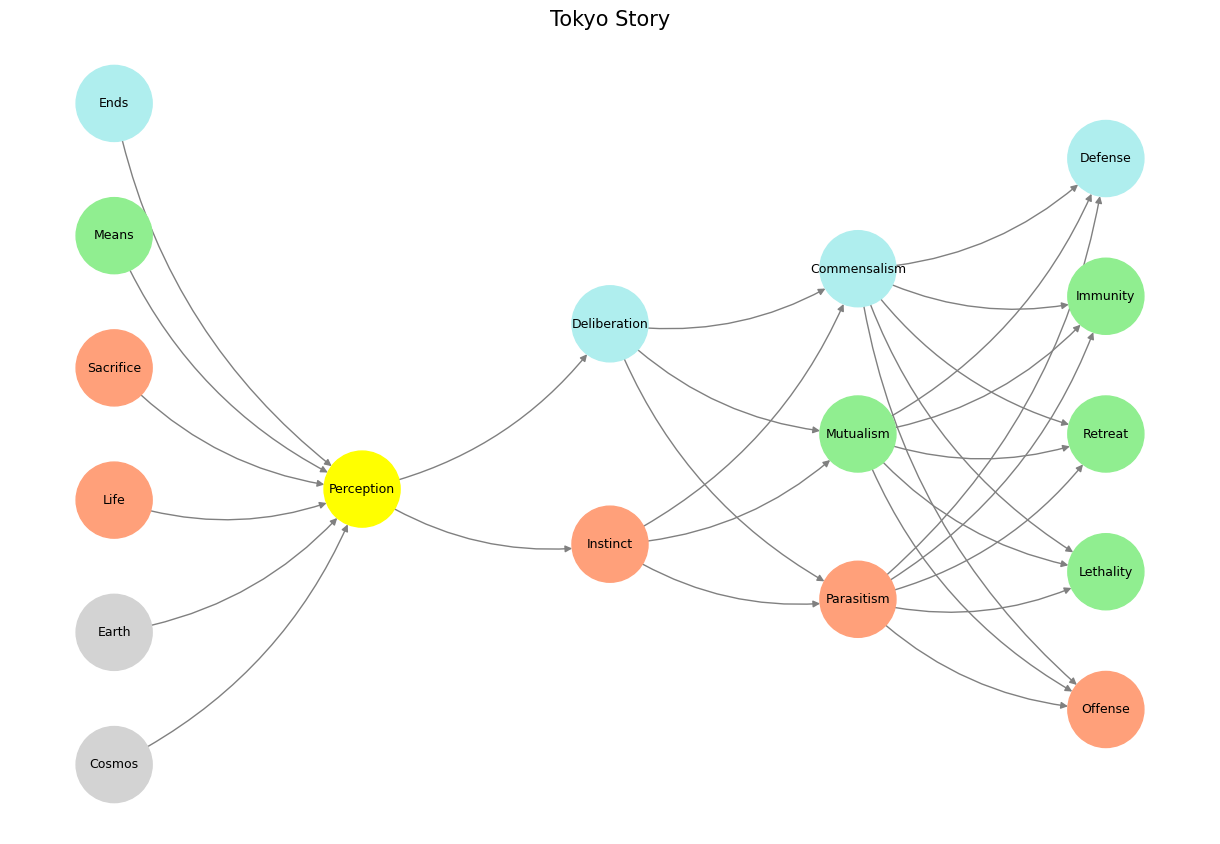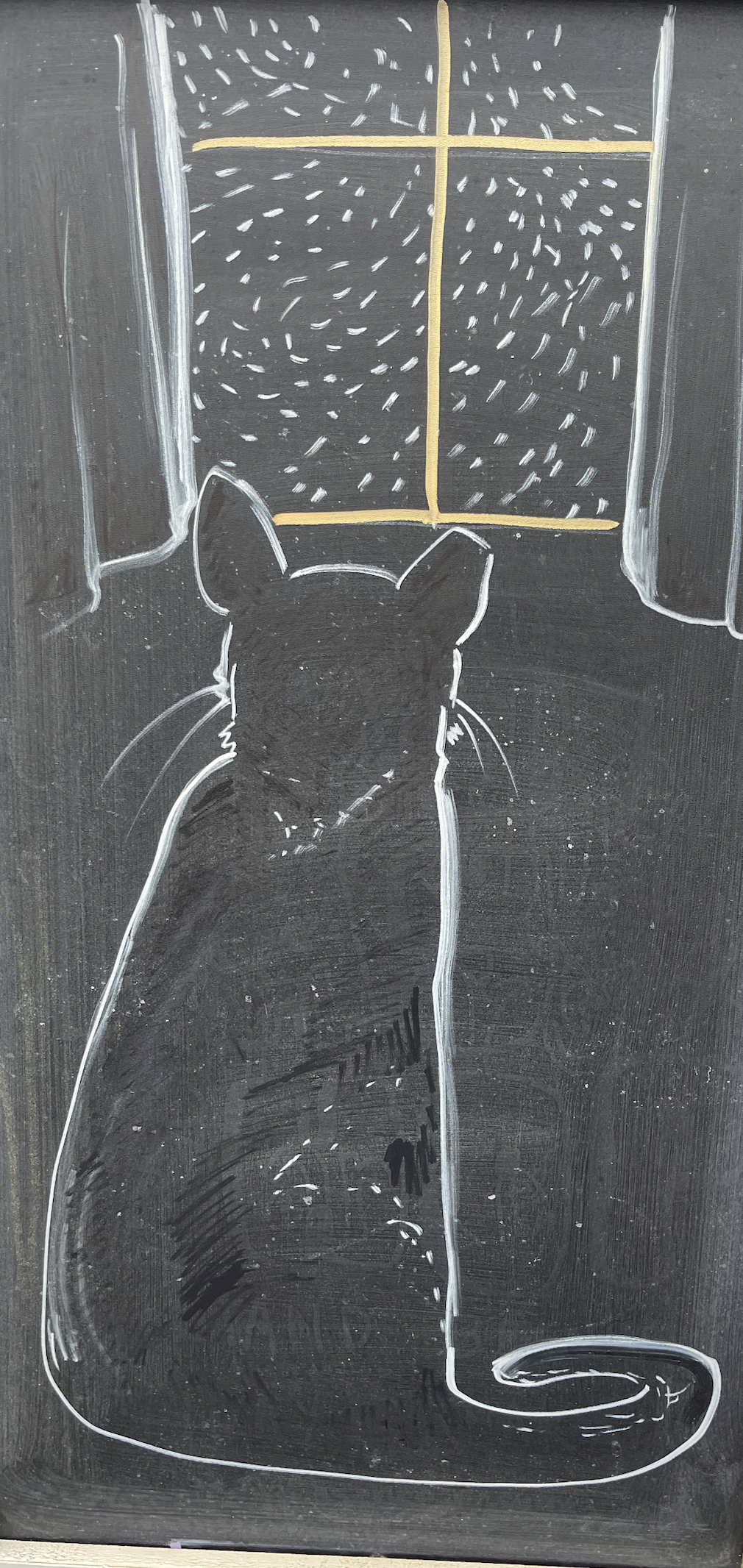Transformation#
The neural network framework you’ve shared invites a fascinating lens for critiquing Tokyo Story, unraveling its layered narrative through pretext, subtext, text, context, and metatext. Each layer of the framework—World, Perception, Agency, Generativity, and Physicality—offers a unique perspective on the film’s intricate structure, capturing its minimalist storytelling and profound thematic resonances.
At its pretextual level, Tokyo Story is a deceptively simple tale of aging parents visiting their adult children in postwar Tokyo, only to discover the indifference of modern life. This setup, corresponding to the “World” layer, captures nodes like “Sacrifice” and “Means,” which frame the elder Hirayamas’ journey as an act of selfless endurance. Their trip is motivated not by personal need but by an instinctive, almost biological desire to remain tethered to their children’s lives, even as the world evolves past the values they represent. The “Earth” and “Life” nodes symbolize the fraught connection between their rootedness in tradition and the shifting ground of modernity.
The textual layer—the narrative as presented—is stark yet emotionally charged, revealing a clash between “Perception” and “Deliberation” within the framework of “Agency.” The children, bound by their own lives, fail to perceive the emotional sacrifice their parents embody, while the parents refrain from explicit confrontation, demonstrating restraint and deliberation. Here, the “Ends” node within the “World” layer becomes critical; the film interrogates whether the children’s indifference is a byproduct of modernity’s relentless focus on personal advancement at the expense of familial bonds.
The subtext operates within “Generativity,” where nodes like “Parasitism,” “Mutualism,” and “Commensalism” illuminate the dynamics between generations. The relationship between the parents and their children, especially the daughters-in-law, fluctuates across these categories. Noriko, the widowed daughter-in-law, embodies “Mutualism,” offering genuine care and emotional reciprocity, contrasting sharply with the biological children, whose interactions veer toward “Parasitism”—benefiting from their parents’ sacrifices without reciprocation. These dynamics underscore how familial bonds are renegotiated in a rapidly modernizing society, subtly critiquing the erosion of traditional values.
In the contextual layer, Tokyo Story is deeply embedded in the postwar realities of Japan. The film’s quiet moments—long, static shots of the urban and rural landscape—echo the dissonance between “Defense” and “Offense” in the “Physicality” layer. The industrialized Tokyo represents an “Offense” against the pastoral rhythms of Onomichi, the parents’ hometown, embodying a broader cultural shift from community-centric to individualistic paradigms. This tension is mirrored in the children’s lives, as they navigate a world that demands retreat and adaptation, often at the expense of traditional roles.
Finally, the metatextual layer—the film as a commentary on cinema itself—reveals the “Perception” node’s centrality. Ozu’s restrained direction eschews melodrama for quiet realism, compelling viewers to actively engage with the emotional undercurrents rather than passively consume them. The absence of overt confrontation mirrors the “Immunity” node, where characters develop an emotional resilience through unspoken acknowledgment rather than cathartic release. Ozu’s meticulous framing and use of “tatami shots” reflect a deliberate recalibration of perspective, aligning the audience with the generational and cultural shifts depicted.
Tokyo Story, when viewed through this neural network framework, reveals itself as a deeply layered meditation on human connection, modernity, and the quiet tragedies of life. Each narrative stratum resonates with nodes from the framework, inviting us to consider how generational divides, cultural shifts, and personal sacrifices are intertwined within the broader matrix of existence. The film’s lasting power lies in its ability to compress these complexities into an understated yet profoundly moving story, where every silence speaks volumes and every action, however small, reverberates with meaning.
Show code cell source
import numpy as np
import matplotlib.pyplot as plt
import networkx as nx
# Define the neural network structure
def define_layers():
return {
'World': ['Cosmos', 'Earth', 'Life', 'Sacrifice', 'Means', 'Ends', ],
'Perception': ['Perception'],
'Agency': ['Instinct', 'Deliberation'],
'Generativity': ['Parasitism', 'Mutualism', 'Commensalism'],
'Physicality': ['Offense', 'Lethality', 'Retreat', 'Immunity', 'Defense']
}
# Assign colors to nodes
def assign_colors():
color_map = {
'yellow': ['Perception'],
'paleturquoise': ['Ends', 'Deliberation', 'Commensalism', 'Defense'],
'lightgreen': ['Means', 'Mutualism', 'Immunity', 'Retreat', 'Lethality'],
'lightsalmon': [
'Life', 'Sacrifice', 'Instinct',
'Parasitism', 'Offense'
],
}
return {node: color for color, nodes in color_map.items() for node in nodes}
# Calculate positions for nodes
def calculate_positions(layer, x_offset):
y_positions = np.linspace(-len(layer) / 2, len(layer) / 2, len(layer))
return [(x_offset, y) for y in y_positions]
# Create and visualize the neural network graph
def visualize_nn():
layers = define_layers()
colors = assign_colors()
G = nx.DiGraph()
pos = {}
node_colors = []
# Add nodes and assign positions
for i, (layer_name, nodes) in enumerate(layers.items()):
positions = calculate_positions(nodes, x_offset=i * 2)
for node, position in zip(nodes, positions):
G.add_node(node, layer=layer_name)
pos[node] = position
node_colors.append(colors.get(node, 'lightgray')) # Default color fallback
# Add edges (automated for consecutive layers)
layer_names = list(layers.keys())
for i in range(len(layer_names) - 1):
source_layer, target_layer = layer_names[i], layer_names[i + 1]
for source in layers[source_layer]:
for target in layers[target_layer]:
G.add_edge(source, target)
# Draw the graph
plt.figure(figsize=(12, 8))
nx.draw(
G, pos, with_labels=True, node_color=node_colors, edge_color='gray',
node_size=3000, font_size=9, connectionstyle="arc3,rad=0.2"
)
plt.title("Tokyo Story", fontsize=15)
plt.show()
# Run the visualization
visualize_nn()


Fig. 29 Teleology is an Illusion. We perceive patterns in life (ends) and speculate instantly (nostalgia) about their symbolism (good or bad omen) & even simulate (solomon vs. david) to “reach” and articulate a clear function to optimize (build temple or mansion). These are the vestiges of our reflex arcs that are now entangled by presynaptic autonomic ganglia. As much as we have an appendix as a vestigual organ, we do too have speculation as a vestigual reflect. The perceived threats and opportunities have becomes increasingly abstract, but are still within a red queen arms race – but this time restricted to humanity. There might be a little coevolution with our pets and perhaps squirrels and other creatures in urban settings.#

